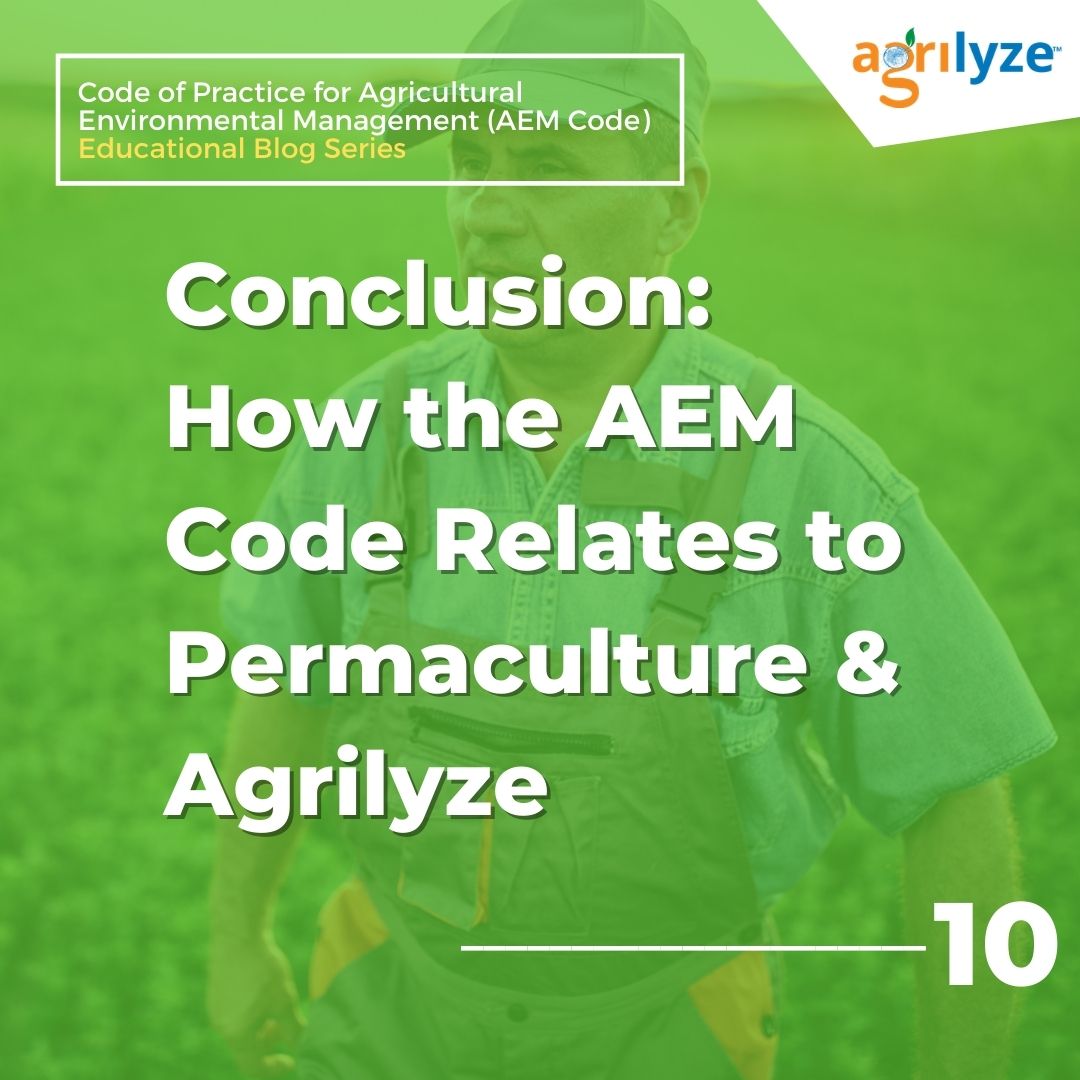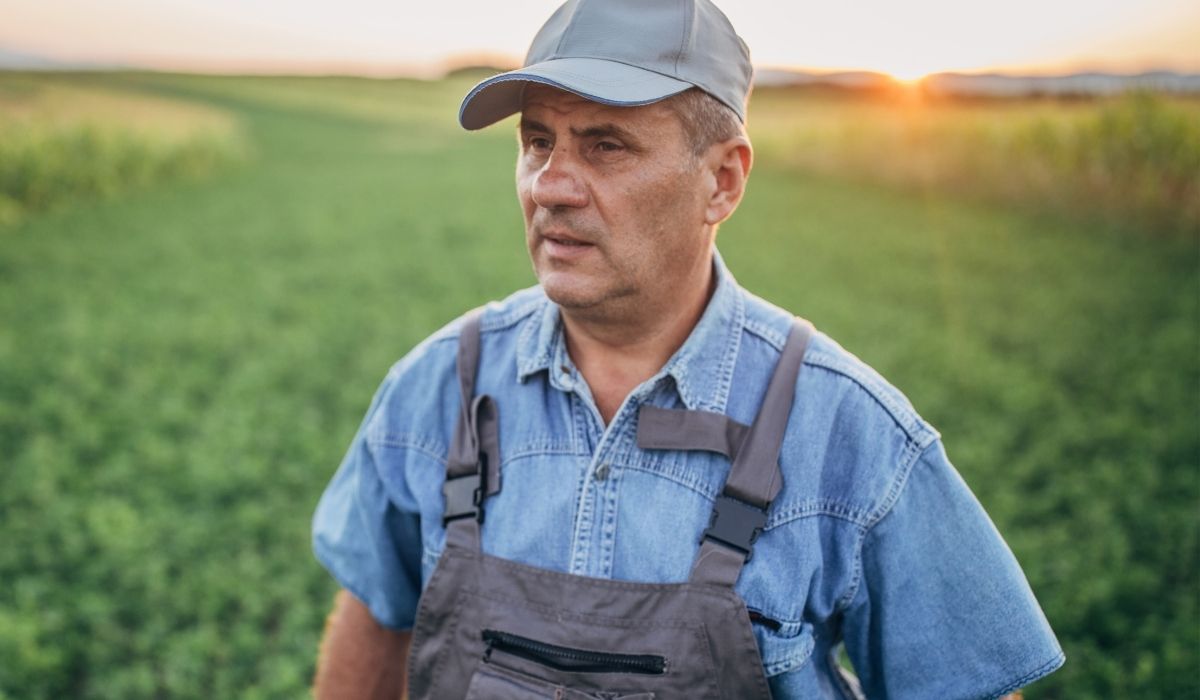Code of Practice for Agricultural Environmental Management – Conclusion (How the AEM Code Relates to Permaculture & Agrilyze)
It is always important to ask questions. What is the point of all of this? What are the benefits, and how does it fit into my life? Let’s explore some answers to these questions by introducing a concept called permaculture as it relates to the Code of Practice for Agricultural Environmental Management and Agrilyze, an innovative platform solution for farmers.
You may already be aware that the Code of Practice for Agricultural Environmental Management (AEM Code) is intended to help farmers protect the environment. The rules aren’t in place to subject farmers to more regulations (although this may be believed to be true) or designed to create new, unforeseen compliance models. When they say ‘code of practice’, we should be hearing, ‘here are some detailed suggestions to help you do the job you know best’. This is an important detail to understand as we take time to educate each other and ourselves. By providing clear outlines that are both risk and science-based, we can take more preventative measures, especially in high-risk conditions. And since the AEM Code applies to all agricultural operations, we can ensure that farms of all sizes and ventures demonstrate a basic level of environmental protection.
Ultimately, the code is helping farmers to become more self-sufficient. Ideally, this can be combined with ideas taken from a concept like permaculture. It is relevant to investigate such connections because most of us understand that our way of life on our planet must change if we will survive long-term. Farmers are faced with challenges that evolve beyond front-facing duties. There are challenges like climate change, feeding a growing population and transitioning toward an eco-friendly, ethical and sustainable future that may be pushed out of the limelight. Why? Because we are all working so hard! Also, we may become enraptured in our acts of service, so much so that we forget we are not involved in a grand scheme but participate together in the BIG picture. Our industry is our peer. What matters most (what is the big picture)? The health and wealth of our land and jobs. What makes a difference? Our experience, combined with a willingness and openness to learn and grow.
Along with helping us to understand the purpose of the Code of Practice for Agricultural Environmental Management, permaculture is an excellent concept to wrap our heads around. It’s a broad outline of potential solutions to the problems we face in the industry. It is also flexible enough that it can endure and thrive for generations to come. The 12 principles of permaculture are most commonly used concerning food growing systems but can also be used to guide us in farming. Let’s see how each principle relates to the AEM Code and the Agrilyze platform. Don’t worry, the benefits are nestled in there!
1 – Observe and Interact
Manage your operation using knowledge plus data.
Think of the Code of Practice for Agricultural Environmental Management as a set of observations. As farmers, growers, or ranchers, we can interact with observations by being aware of the specific requirements that apply to our agricultural operation.
Agrilyze takes this into account. We provide high-level data that can be used to better observe and interact with our work. For example, use the platform to observe where nutrients are applied, then interact with your findings and document an effective nutrient management plan.
2 – Catch & Store Energy
Gather and aggregate data into a unified, easy-to-use, browser/app-based platform.
Energy is abundant on our planet and learning how to ‘catch and store’ that energy is vital to our role as farmers. The Code of Practice for Agricultural Environmental Management provides several guidelines for efficient use of abundant energy sources, such as ensuring that boilers and heaters operate with lower environmental impacts and better temperature control. We must meet a design standard, which is how they put it.
Agrilyze can notify you when sensors go out of range by sending a notification if the temperature drops too low. A wireless temperature alarm is indispensable if you want to keep a healthy greenhouse so that you can track problems such as power outages, temperature fluctuations, water damage, and intrusion.
3 – Obtain a Yield
Stay on top of trends and industry advances, so you can better measure, analyze and interpret farm data.
It is important to design systems that will best leverage your activity and avoid wasting energy and resources on things that do not provide value. Having a goal in mind will help you reach your targets. For example, according to the AEM Code, by choosing your composting site carefully, you can reduce the potential for environmental impact and respect neighbouring land uses. By obtaining a yield, farmers can improve compost quality and keep track of when compost was turned and the compost’s conditions at specific times.
Agrilyze takes it a step further by allowing you to measure outputs with sensors (temp/moisture – IoT devices), therefore tracking nutrients in compost and understanding where to apply it to (soil testing), as well as analyzing detailed information over time (analytics).
4 – Apply Self-Regulation and Feedback
Identify where you are succeeding and lacking results.
As farming is continually changing, the AEM Code can help identify problem areas and manage environmental challenges with detailed guidelines that farmers can easily apply. A systems-oriented approach can help address the problematic issues associated with the complexity of food and other production systems in different ecologies and locations.
This is the same benefit of a platform like Agrilyze. It gives farmers valuable feedback, impacting our business processes and relationship to our land and our job. Fundamentally, we can always make better decisions. For example, have real-time analytics on hand to analyze detailed information over time or have quick and easy access to relevant documentation related to composting, soil, water etc. Agrilyze helps farmers apply new techniques to boost yields and increase growth and competitiveness in the agricultural market.
5 – Use and Value Renewables
Move toward a more sustainable practice.
According to the AEM Code, we should build storage facilities for waste products that promote safety, protect the environment, and can be reused or recycled later. When we think about manure’s value alone, we should find specific uses for it, such as introducing nitrogen and organic matter into your soil to improve your soil’s fertility and structure.
Agrilyze works with farmers to map their farm (Map My Farm). As an example, this application allows farmers to track where the manure is stored and used, critical setbacks outlined by the legislation and locations of principal features such as high-water tables, flood-prone areas, and water bodies, including aquifers.
6 – Produce No Waste
Reuse or recycle wherever possible.
According to the AEM Code, farmers have the opportunity to reduce waste by following steps like properly managing the storage and disposal of wastewater to ensure that pollution does not enter into waterways. Farmers need to use proper management techniques to reduce waste and our reliance on chemical pesticides, control pests, and ultimately protect the environment.
Agrilyze helps by tracking environmental and physical components like soil types, aquifers, or weather and relates it to manure applications, then correlates inputs and outputs to ensure that the farm produces less waste overall.
7 – Design from Patterns to Details
Analyze & build actionable data from financial information and spreadsheets.
This is the idea that by thinking holistically, the farm can grow and thrive. One key concept that contributes to this idea is organization. The AEM Code emphasizes that farmers must keep records of their farm activities, contributing to more efficient management, informed decisions, and a future plan.
By creating simple forms that work on desktop/mobile, tracking and analyzing progress over time and storing data in an auditable database, Agrilyze helps keep farmers organized. It responds to our needs and then, combined with better organization, gives farmers the power to concentrate on more crucial business areas.
8 – Integrate Don’t Segregate
Understand your farms, fields & crops better with precise mapping.
As we’ve discussed, to make a change, we must be open to change itself, honest and willing to work with new approaches like the AEM Code. One prime example is keeping a nutrient management plan. It offers many benefits, including having a better understanding of how various crops interact in the landscape. Instead of creating silos and segregating data, we have the opportunity to integrate it and make it more worthwhile.
Agrilyze can help farmers collect relevant data, then combine the data to track and improve usage patterns on the farm or better track soil nutrients to apply the correct amounts yielding the maximum economic benefit. Use the Agrilyze platform to harness the power of location – identify property lines, fields, crops, buildings, soil test locations, manure storage and animal housing and their setbacks in relation to any watercourses, wells, or other areas of concern.
9 – Use Small, Slow Solutions
Take what you can handle, one step at a time.
We understand that there’s value in your data and that you are required to do things in a certain way. We also know that you are looking for a competitive advantage. We presented the Code of Practice for Agricultural Environmental Management as an invitation to explore new ways to farm smarter and stronger. It may seem daunting at first, but every small step counts. These guidelines are small in comparison to the bigger picture. You can become a part of the solution, not by reacting but by responding!
Agrilyze is equipped to help farmers find solutions to operational challenges. Transitioning toward a technology-based system takes time, and the Agrilyze team is here to provide context and correlations that make sense. We provide training and mentorship. As succession planning becomes a reality, we must nurture the next generation of farmers by using technology ourselves.
10 – Use and Value Diversity
Promote more diversity and stability in the industry.
Your operation is different than your neighbours and we value that. However, stability comes with a price. It’s time to look into new ways to automate typical farming processes, giving you more insight and data to improve productivity and efficiency. Smallholding or commercial enterprise, the AEM Code is in place to help you produce better results.
For example, to carefully raise livestock and poultry, various factors must be considered. Agrilyze can help make sure farms have suitable housing and follow regulations regarding cleanliness and clean water. Agrilyze makes it easy to manage this aspect by providing AI to recognize hazards and security risks before they become a problem.
11 – Use Edges and Value the Marginal
Get your agricultural site’s compliance requirements, allowing for a more straightforward understanding of what is required.
The whole idea behind minimum setbacks is to create edges around marginal space to set back agricultural activities away from watercourses, drinking water sources, and property boundaries. We can avoid harmful damage to the environment by adhering to the AEM Code.
With the Map my Farm setup at the implementation of Agrilyze, key features are identified (farm boundaries, field edges, watercourses, wells, storage facilities), then the appropriate setbacks are applied to give farms a clear understanding of the requirements.
12 – Creatively Use and Respond to Change
Farm smarter. Start today.
This might sound cliché, but change is always happening. It is a regular part of life. Ultimately, permaculture matters because it impacts our future and not just the present. We all operate within an established framework; however, the design could change. The AEM Code is one way to implement design changes on our farm.
Whether it be the changing seasons or climate, our attitude toward change will shape how well we can integrate technologies like Agrilyze into our approach. Technology is like creativity. It generates and recognizes ideas, alternatives, or possibilities that can change the way we live. Period.
I once met a decidedly different farmer. He was not stuck in his ways but worrisome, open and honest about dealing with new regulations. He was also sophisticated and intelligent. Now, this is essential to understand. Those of us who interact with farmers should take the time to communicate how some things can help more than others. Apply the Code of Practice for Agricultural Environmental Management, use Agrilyze to become more self-sufficient in a more sustainable way. Protect the environment and the businesses we operate. We hope that by connecting the twelve principles of permaculture to a method, we can inspire a more altruistic farming system based on diversity, resilience and results. Did you learn a lot? We hope so! Our next series will focus on agtech careers and presentations in collaboration with BC Agriculture in the Classroom. Keep learning, and never stop growing. If you have any questions at all, please feel free to send us an email at [email protected].



